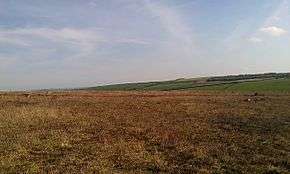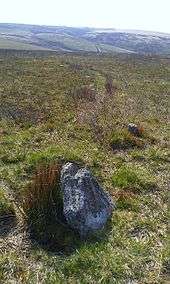Withypool Stone Circle
 The location of the circle in 2014; the stones are so small that discerning the site is difficult | |
 Shown within Somerset | |
| Location | Withypool |
|---|---|
| Coordinates | 51°05′47″N 3°39′37″W / 51.096383°N 3.660378°W |
| Type | Stone circle |
| History | |
| Periods | Neolithic / Bronze Age |
Withypool Stone Circle, also known as Withypool Hill Stone Circle, is a stone circle located near to the village of Withypool in the south-western English county of Somerset. It is found within Exmoor. The Withypool ring is part of a tradition of stone circle construction that spread throughout much of Britain, Ireland, and Brittany during the Late Neolithic and Early Bronze Age, over a period between 3,300 and 900 BCE. The purpose of such monuments is unknown, although archaeologists speculate that they were likely religious sites, with the stones perhaps having supernatural associations for those who built the circles.
Although Exmoor witnessed the construction of a large number of monuments during the Bronze Age, only two stone circles survive in this area, the other being Porlock Stone Circle. The Withypool ring is located on the south-western slope of Withypool Hill, on an area of heathland. In diameter it measures 36.4 metres (119 feet, 6 inches) across. Around thirty small gritstones remain as part of the circle, which may originally have held around one hundred; there are conspicuous gaps on the northern and western ends of the monument. The site was rediscovered in 1898 and subsequently surveyed by the archaeologist Harold St George Gray in 1905.
Location
Withypool Stone Circle is located on the south-western slope of Withypool Hill,[1] with some sources referring to it as Withypool Hill Stone Circle.[2] The site is at a height of 381 meters (1250 feet) above sea level.[3] It is 670.25 meters (733 yards) east-southeast of Portford Bridge,[4] and two and three-quarter miles south/south-west of Exford.[5]
The land on which the circle is located slopes down from east to west.[4] The topsoil in and around the site is peaty and has heather growing across it.[4] From the circle, a range of different Bronze Age round barrows, or tumuli, are visible at different points in the surrounding landscape.[5] 261.5 meters (286 yards) to the north-east of the circle, atop the summit of Withypool Hill, is a lone tumulus, although this can no longer be seen from Withypool Stone Circle itself.[3] The three Brightworthy Barrows can be seen from the circle in a north-west direction.[3] Other Bronze Age barrows visible from the circle are the Green Barrow, the Old Barrow, the Twitchen Barrows, the three Wam Barrows of Winsford Hill, and the barrow atop Sherdon.[3] Also visible from the circle is a scatter of over thirty stones on the Westwater Allotment; these are up to 0.5m (1.6 feet) long, with two reported as being standing in 1988.[6] Elsewhere on Withypool Common is a collection of six stones arranged in a roughly circular fashion, which may have represented another stone circle or perhaps the kerbstones from a since-destroyed round cairn.[7]
Context
.jpg)

While the transition from the Early Neolithic to the Late Neolithic—which took place with the transition from the fourth to the third millennium BCE—witnessed much economic and technological continuity, it also saw a considerable change in the style of monuments erected, particularly in southern and eastern England.[8] By 3000 BCE, the long barrows, causewayed enclosures, and cursuses which had predominated in the Early Neolithic had ceased being built, and were instead replaced by circular monuments of various kinds.[8] These include earthen henges, timber circles, and stone circles.[9] These latter circles are found in most areas of Britain where stone is available, with the exception of the island's south-eastern corner.[10] They are most densely concentrated in south-western Britain and on the north-eastern horn of Scotland, near Aberdeen.[10]
These stone circles typically show very little evidence of human visitation during the period immediately following their creation.[11] This suggests that they were not sites used for rituals that left archaeologically visible evidence, and may have been deliberately left as "silent and empty monuments".[12] The archaeologist Mike Parker Pearson suggested that in Neolithic Britain, stone was associated with the dead and wood with the living.[13] Other archaeologists have suggested that the stone might not represent ancestors, but rather other supernatural entities, such as deities.[12]
There are only two known prehistoric stone circles located on Exmoor: Withypool and Porlock Stone Circle.[14] The archaeologist Leslie Grinsell noted that there was a circular stone monument on Almsworthy Common that was "probably" also the remains of a stone circle,[15] although P. J. D. Way argued that it was a rectilinear stone setting, perhaps a series of parallel stone rows.[16] Archaeologists have attributed these circles to the Late Neolithic or Early Bronze Age,[17] and have noted that they are comparable to the stone circles found further south, in Dartmoor.[17] However, in contrast to the two known Exmoor circles, over seventy such monuments have been identified on Dartmoor.[18] This may be because Exmoor, unlike Dartmoor, has no natural granite.[18] Instead it has Devonian slates and Hangman Grits, both of which easily break up into small slabs, resulting in a general shortage of big stones on Exmoor.[18]
Exmoor also has a henge located near to Parracombe, although it has been damaged by ploughing.[18] Alongside this, the moor bears a profusion of other Bronze Age monuments, including between 300 and 400 round barrows, standing stones, and linear stone settings.[18] The creation of these different monument types might explain why so few stone circles were apparently created here.[19] Most of the surviving prehistoric stone monuments on Exmoor are located on those areas of moorland outside the limits of medieval and post-medieval agriculture. For this reason it is likely that the surviving sites are not a reliable indicator of the original extent of these sites.[17]
Description

The stone circle measures 36.4 metres (119 feet, 6 inches) in diameter.[20] As of 1905, there were thirty-seven stones remaining in the circle.[20] At the time there were conspicuous gaps on the northern and western sides of the ring, with the stones perhaps having been removed for use as road metal.[21] In 1915 it was reported that one of the previously recorded stones had been removed but that three additional stones had been found in the circle.[22] By 1988, Martin J. F. Fowler reported that there were only twenty-nine stones in the circle.[6] Conversely, the following year Burl reported thirty stones, of which three had fallen and twenty-seven remained standing.[5] Originally it may have included around a hundred stones, spaced about one metre (3 feet 6 inches) apart.[23]
The stones themselves are small; on average they measure 0.1 metre (4 inches) in height, 0.3 metre (one foot) in width, and 0.1 metres (4 inches) thick.[5] The largest stands approximately 0.5 metres (1.6 feet) above the ground.[6] Most are incomplete, and likely have been broken since the original erection of the circle.[24] Although it is not known if all the stones in the circle come from the same natural rock, a sample was taken from one stone and under examination revealed to be a hard, pale grey gritstone, likely taken from the nearby Pickwell Down grits.[25] There are conspicuous quartz veins in many of the circle's stones.[25]
Investigation
The site was first rediscovered by accident in 1898 when Archibald Hamilton was riding across Withypool Heath. His horse stumbled against one of the stones, and on further investigation he located other stones within the bracken.[26] After the bracken on the heath was burned away, something that took place periodically to encourage new growth, Hamilton returned to get a better look at the circle.[27] He contacted Colonel Bramble, the Vice President of the Somerset Archaeological and Natural History Society, who put him in touch with the archaeologist Harold St George Gray.[4] Gray then accompanied Hamilton on a visit to the site in August 1905, at which point he made a survey of the ring.[28]
Gray published his findings in a 1906 volume of the Proceedings of the Somerset Archaeological and Natural History Society, in which he drew comparisons between the site and two Cornish stone circles that he had recently surveyed, Fernacre and Stannon stone circle.[29] He proffered the suggestion that the circle had been the site of cremations, with the cremated human remains then being buried within the nearby tumuli.[30] In August 1909, Gray returned to the site for the first time in nine years.[31] He noted that the circle was in largely the same condition as before, but that the ling and whortleberry bushes around the site were more stunted than they had previously been.[32]
The site has been categorised as a scheduled monument since 1925, and thus is accorded legal protection under the Ancient Monuments and Archaeological Areas Act 1979.[33][34]
References
Footnotes
- ↑ Gray 1906, p. 43; Burl 2005, p. 80.
- ↑ Grinsell 1970, p. 39.
- 1 2 3 4 Gray 1906, p. 44.
- 1 2 3 4 Gray 1906, p. 43.
- 1 2 3 4 Burl 2005, p. 80.
- 1 2 3 Fowler 1988, p. 11.
- ↑ Fowler 1988, p. 12.
- 1 2 Hutton 2013, p. 81.
- ↑ Hutton 2013, pp. 91–94.
- 1 2 Hutton 2013, p. 94.
- ↑ Hutton 2013, p. 97.
- 1 2 Hutton 2013, p. 98.
- ↑ Hutton 2013, pp. 97–98.
- ↑ Burl 2000, p. 150; Riley & Wilson-North 2001, p. 24; Gillings 2015, p. 1.
- ↑ Grinsell 1970, p. 38.
- ↑ Grinsell 1970, p. 41.
- 1 2 3 Riley & Wilson-North 2001, p. 24.
- 1 2 3 4 5 Burl 2000, p. 150.
- ↑ Burl 2000, p. 151.
- 1 2 Gray 1906, p. 46; Burl 2005, p. 80.
- ↑ Gray 1906, p. 46.
- ↑ Anon 1915, p. xxix.
- ↑ Gray 1906, p. 46; Grinsell 1970, p. 39; Burl 2005, p. 80.
- ↑ Gray 1906, pp. 46–47.
- 1 2 Gray 1906, p. 48.
- ↑ Gray 1906, p. 41; Burl 2005, p. 80.
- ↑ Gray 1906, pp. 42–43.
- ↑ Gray 1906, p. 43; Riley & Wilson-North 2001, p. 23.
- ↑ Gray 1906, pp. 47, 48.
- ↑ Gray 1906, p. 47.
- ↑ Anon 1915, p. xxviii.
- ↑ Anon 1915, pp. xxviii–xxix.
- ↑ "Stone circle on Withypool Hill 670m ESE of Portford Bridge". Historic England. Retrieved 15 February 2017.
- ↑ "MSO8682 - Withypool Stone Circle, Withypool Hill". Exmoor Historic Environment Record. Exmoor National Park. Retrieved 19 February 2017.
Bibliography
- Anon (1915). "The Withypool Stone Circle". Proceedings of the Somerset Archaeological and Natural History Society. 61: xxviii–xxix.
- Burl, Aubrey (2000). The Stone Circles of Britain, Ireland and Brittany. New Haven and London: Yale University Press. ISBN 978-0-300-08347-7.
- ——— (2005). A Guide to the Stone Circles of Britain, Ireland and Brittany. New Haven and London: Yale University Press. ISBN 978-0-300-11406-5.
- Gillings, Mark (2015). "Excavation and Survey at Porlock Stone Circle and Row, Exmoor". Proceedings of the Somerset Archaeological and Natural History Society. 158: 1–28.
- Gray, Harold St George (1906). "The Stone Circle on Withypool Hill, Exmoor". Proceedings of the Somerset Archaeological and Natural History Society. 52: 42–50.
- Grinsell, Leslie V. (1970). The Archaeology of Exmoor: Bideford Bay to Bridgwater. Newton Abbot: David and Charles. ISBN 978-0-7153-4953-3.
- Fowler, Martin J. F. (1988). "The Standing Stones of Exmoor: A Provisional Catalogue of 62 West Somerset Sites". Proceedings of the Somerset Archaeological and Natural History Society. 132: 1–13.
- Hutton, Ronald (2013). Pagan Britain. New Haven and London: Yale University Press. ISBN 978-0-300-19771-6.
- Riley, Hazel; Wilson-North, Robert (2001). The Field Archaeology of Exmoor. Swindon: English Heritage. ISBN 1-873592-58-2.
External links
| Wikimedia Commons has media related to Withypool Stone Circle. |
- Withypool Stone Circle at Pastscape
- Withypool Stone Circle at The Megalithic Portal
- Withypool Stone Circle at The Modern Antiquarian